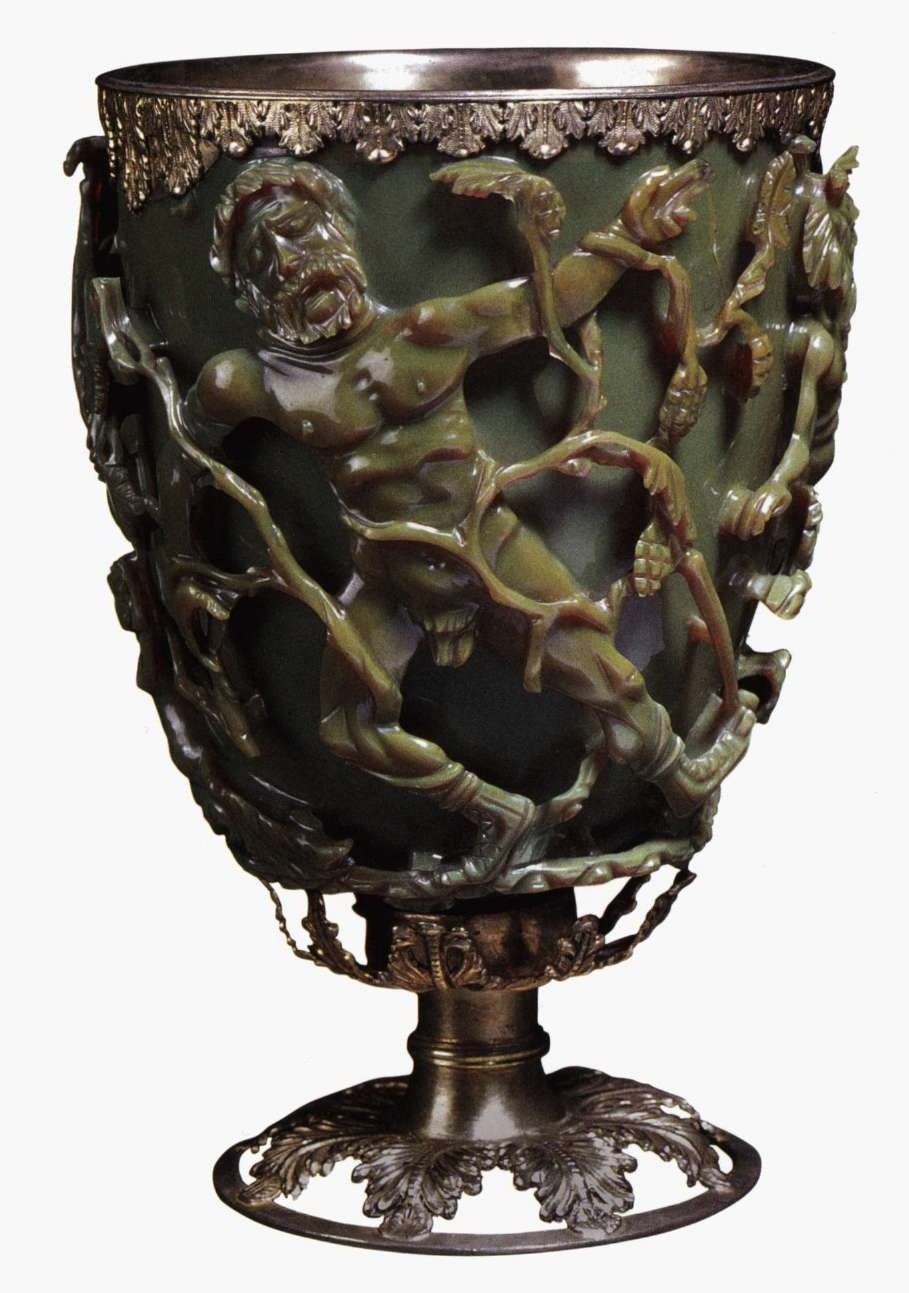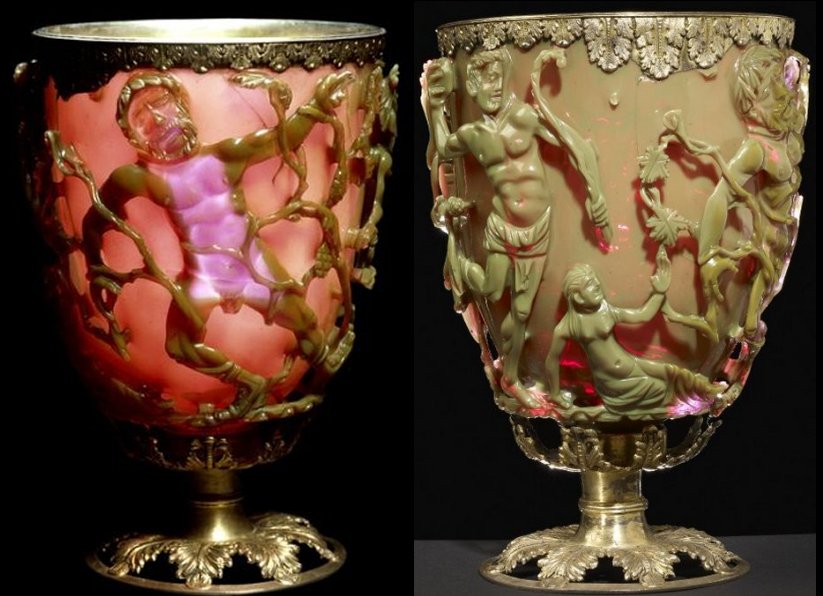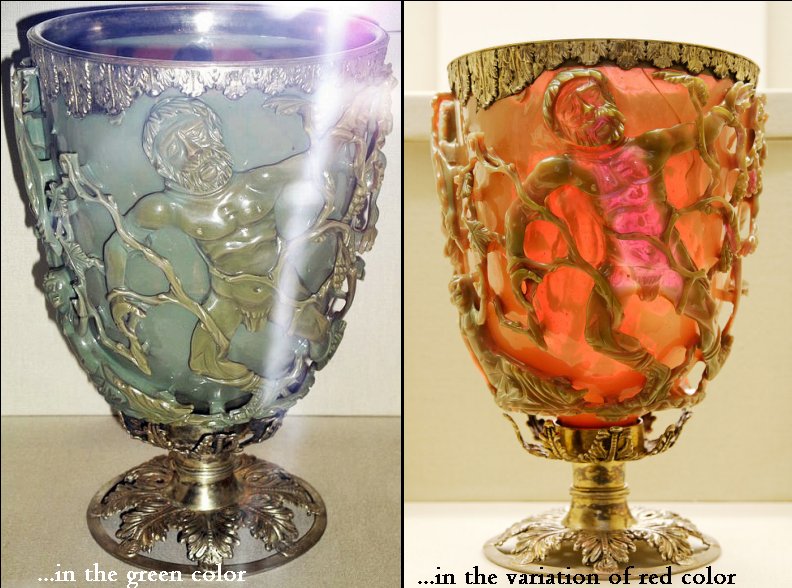The Lycurgus Cup: Fascinating Artifact That Reveals Prehistoric Knowledge Of Nanotechnology
A. Sutherland - AncientPages.com - Although nanotechnology represents a new, relatively modern concept and is related to ultrahigh precision and ultra-small sizes, the term "nano" is old. It comes from the Greek word "nanos," which means "dwarf."
This extraordinary Lycurgus cup is the only surviving complete example made from dichroic glass, which changes color when held up to the light. When light is shone through the body of the cup it turns from opaque green to a glowing translucent red. The glass contains tiny amounts of colloidal gold and silver, which give it these unusual optical properties. Image credit: British Museum
Knowledge about metallic nanoparticles has been used since ancient times, especially regarding the unusual colors in antique glass and ceramic objects. It is believed that the use of metallic nanoparticles started with the beginning of glass-making in Egypt and Mesopotamia, dating back to the fourteenth and thirteenth centuries BC.
The most remarkable example of the use of metallic nanoparticles is the Lycurgus Cup, a piece of Roman glasswork dating from the fourth century CE, showing a mythological scene depicting the legend of King Lycurgus.
"....Glass-producing techniques were highly developed, and workmanship was superb.
In the Lycurgus Cup, now housed in the British Museum, the 324 AD victory of Constantine over Licinius in Thrace was represented through the death of an enemy of Dionysius, Lycurgus, who is shown being overcome by vines...." Daniel L. Schodek, Paulo Ferreira, Michael F. Ashby write in their book "Nanomaterials, Nanotechnologies and Design."
The satyr with the rock, in the new 2014 display in the British Museum. Image credit: Johnbod - CC BY-SA 3.0
The theme of this myth - the triumph of Dionysius over Lycurgus - might have been chosen to refer to a contemporary political event, the defeat of the emperor Licinius (reigned AD 308-24) by Constantine in AD 324.
The Lycurgus Cup exhibits a color-changing property that makes its glass take on different hues depending on the light source. The changes in the colors have been a scientific mystery for a long time.
In the 1990s, researchers noticed tiny particles of silver and gold in the cup's glass, and it became clear that light played an important role when the Romans created the cup. When hit with light, electrons belonging to the metal flecks vibrated in ways that altered the color depending on the observer's position.
Researchers attempt to build the unique technology used in the artifact and apply it in the medical field. Still, they cannot do it using the original artifact, so they use a replica of the artifact, allowing them to pursue their ideas. The replica is a color-changing cup on a much smaller scale, imprinting billions of microscopic wells on a plastic plate with the same nanoparticles.
The most famous example of the use of metallic nanoparticles concerns a piece of Roman glasswork, the Lycurgus Cup, dating from the fourth century CE, showing a mythological frieze depicting the legend of King Lycurgus. British Museum, rum 41
According to the British Museum, this is the only complete "dichroic" glass example. The opaque green cup turns to a glowing translucent red when light is shone through it. The glass contains tiny amounts of colloidal gold and silver, which give it unusual optical properties.
The cup is also the only figural example of a vessel known as a 'cage-cup.' The cup was made by blowing or casting a thick glass blank.
It was cut and ground away until the figures were left in high relief. Sections of the figures are almost standing free and connected only by 'bridges' to the vessel's surface.
According to Historia Augusta", a late Roman collection of biographies of the Roman Emperors, written in Latin and possibly dated to the third and early fourth centuries, two dichroic glasses were delivered as gifts from Hadrian to his brother-in-law Servianus through a record.
Lycurgus cup, variations of color. When viewed in reflected light, as in this flash photograph, the cup's dichroic glass is green in color, whereas when viewed in transmitted light, the glass appears red. British Museum. Image credit: Johnbod - CC BY-SA 3.0
It might have been one of these. Vopiscus detailed some dichroic glasses in "The Lives of Firmus, Saturninus, Proculus and Bonosus" from the "Historia Augusta."
He refers to correspondence supposedly composed by Hadrian to his brother-in-law Servianus:
"I am giving you over some glasses, shifting colors, given to me by the temple priest, especially to you and my sister. I would like you to utilize them on feast days".
The Lycurgus cup is a fantastic artifact - proof of the very advanced skills of its manufacturer.
The result of this extreme work is a high sculpture linked to the surface of the glass with thin connections. On the Lycurgus cup, these connections are grapevines along with other figural components.
Were the ancient Romans familiar with nanotechnology? Is it one of alchemy's secrets? If not, where did this knowledge and technological skills come from? Some believe this extraordinary artifact is far older than ancient Greece or Rome.
If the Greek or Roman masters invented this nanotechnology, why are there no other examples of their skills?
Updated on March 27, 2024
Written by – A. Sutherland AncientPages.com Staff Writer
Copyright © AncientPages.com All rights reserved. This material may not be published, broadcast, rewritten or redistributed in whole or part without the express written permission of AncientPages.com
Expand for referencesReferences:
Schodek L.D., Ferreira P., Ashby M. F. "Nanomaterials, Nanotechnologies and Design"
More From Ancient Pages
-
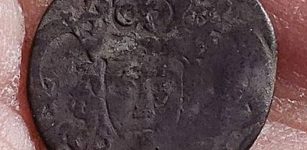 1,000-Year-Old Coin And Other Finds Unearthed During Excavations At Carrignacurra Castle in Cork
Archaeology | Oct 6, 2022
1,000-Year-Old Coin And Other Finds Unearthed During Excavations At Carrignacurra Castle in Cork
Archaeology | Oct 6, 2022 -
 Frightening Legend Of Tate’s Hell Swamp And The Curse Of The Native American Medicine Man
Featured Stories | Feb 12, 2022
Frightening Legend Of Tate’s Hell Swamp And The Curse Of The Native American Medicine Man
Featured Stories | Feb 12, 2022 -
 Baku’s Mysterious Maiden Tower – Legend Of The Daughter Of Fire Who Saved The Sacred Temple May Be True
Featured Stories | Jul 5, 2021
Baku’s Mysterious Maiden Tower – Legend Of The Daughter Of Fire Who Saved The Sacred Temple May Be True
Featured Stories | Jul 5, 2021 -
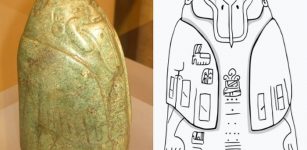 Strange Tuxtla Statuette And Its Undeciphered Inscription – An Epi-Olmec Puzzle
Artifacts | Mar 14, 2018
Strange Tuxtla Statuette And Its Undeciphered Inscription – An Epi-Olmec Puzzle
Artifacts | Mar 14, 2018 -
 Archaeological Site Along The Nile Reveals The Nubian Civilization That Flourished In Ancient Sudan
Civilizations | Apr 14, 2022
Archaeological Site Along The Nile Reveals The Nubian Civilization That Flourished In Ancient Sudan
Civilizations | Apr 14, 2022 -
 Massive trophy skull rack discovered in the Aztec ruins
Artifacts | Aug 22, 2015
Massive trophy skull rack discovered in the Aztec ruins
Artifacts | Aug 22, 2015 -
 Mystery Of Biblical Noah’s Strange Connection With Red-Skinned Giants And The Watchers – Celestial Secrets – Part 2
Ancient Mysteries | Jan 28, 2021
Mystery Of Biblical Noah’s Strange Connection With Red-Skinned Giants And The Watchers – Celestial Secrets – Part 2
Ancient Mysteries | Jan 28, 2021 -
 Remarkably Well-Preserved 1,900-Year-Old Chinese Bronze Mirror Unearthed In Japan
Archaeology | Dec 29, 2017
Remarkably Well-Preserved 1,900-Year-Old Chinese Bronze Mirror Unearthed In Japan
Archaeology | Dec 29, 2017 -
 Unique Wooden Stave Churches Were Built Without Nails – Remarkable Technology Helped Them Survive
Featured Stories | Nov 15, 2022
Unique Wooden Stave Churches Were Built Without Nails – Remarkable Technology Helped Them Survive
Featured Stories | Nov 15, 2022 -
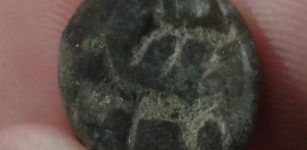 Rare 3,000-Year-Old Seal From The Time Of King David Discovered
Artifacts | Sep 28, 2015
Rare 3,000-Year-Old Seal From The Time Of King David Discovered
Artifacts | Sep 28, 2015 -
 Aztec Empire: ‘Tlatoani’ – The Ruler With The Ultimate Power In The Land
Ancient History Facts | May 5, 2016
Aztec Empire: ‘Tlatoani’ – The Ruler With The Ultimate Power In The Land
Ancient History Facts | May 5, 2016 -
 Unique Medieval Perfectly Preserved Sword Found In The Odra River, Poland
Archaeology | Aug 12, 2020
Unique Medieval Perfectly Preserved Sword Found In The Odra River, Poland
Archaeology | Aug 12, 2020 -
 Ancient DNA And Historical Context Were Used To Explain Kinship, Social Practices Of Avar Society
Archaeology | Apr 25, 2024
Ancient DNA And Historical Context Were Used To Explain Kinship, Social Practices Of Avar Society
Archaeology | Apr 25, 2024 -
 Scientists Unravel Why Humans Used Tiny Flakes 300,000 Years Ago
Archaeology | Dec 15, 2022
Scientists Unravel Why Humans Used Tiny Flakes 300,000 Years Ago
Archaeology | Dec 15, 2022 -
 Thousands Of Cannonballs Discovered In Southern India
Archaeology | Dec 23, 2015
Thousands Of Cannonballs Discovered In Southern India
Archaeology | Dec 23, 2015 -
 Superhighways Traveled By The First Australians Reveal A 10,000-Year Journey Through The Continent – New Study
Archaeology | Feb 3, 2023
Superhighways Traveled By The First Australians Reveal A 10,000-Year Journey Through The Continent – New Study
Archaeology | Feb 3, 2023 -
 Mag Mell: Irish Tradition Of Otherworldly Paradise That Could Be Reached Through Death And Glory
Celtic Mythology | Feb 26, 2019
Mag Mell: Irish Tradition Of Otherworldly Paradise That Could Be Reached Through Death And Glory
Celtic Mythology | Feb 26, 2019 -
 We Need To Look Underwater To Understand Our Past – New Study
Archaeology | Apr 14, 2023
We Need To Look Underwater To Understand Our Past – New Study
Archaeology | Apr 14, 2023 -
 On This Day In History: Planet Neptune Officially Discovered – On Sep 23, 1846
News | Sep 23, 2016
On This Day In History: Planet Neptune Officially Discovered – On Sep 23, 1846
News | Sep 23, 2016 -
 Old Kingdom Mastaba Decorated With Rare Paintings Found In Dahshur Necropolis, Egypt
Archaeology | Mar 22, 2024
Old Kingdom Mastaba Decorated With Rare Paintings Found In Dahshur Necropolis, Egypt
Archaeology | Mar 22, 2024

